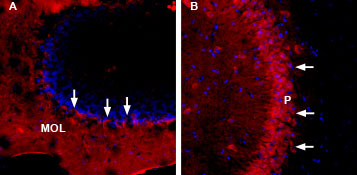Overview
- Peptide (C)ELGLSKLKESGKHQS, corresponding to amino acid residues 141-155 of rat SARAF (Accession Q6AYN2). Intracellular, lumen.

 Expression of TMEM66 in mouse brainImmunohistochemical staining of mouse cerebellum and hippocampus free floating-frozen sections using Anti-TMEM66-ATTO Fluor-594 Antibody (#ACC-067-AR). A. TMEM66 staining (red) in cerebellum appears in the molecular layer (MOL) and in Purkinje cells (arrows). B. In the hippocampus, TMEM66 immunostaining (red) appears in CA3 pyramidal layer (P), (arrows). Nuclei are stained using DAPI as the counterstain (blue).
Expression of TMEM66 in mouse brainImmunohistochemical staining of mouse cerebellum and hippocampus free floating-frozen sections using Anti-TMEM66-ATTO Fluor-594 Antibody (#ACC-067-AR). A. TMEM66 staining (red) in cerebellum appears in the molecular layer (MOL) and in Purkinje cells (arrows). B. In the hippocampus, TMEM66 immunostaining (red) appears in CA3 pyramidal layer (P), (arrows). Nuclei are stained using DAPI as the counterstain (blue).
TMEM66 (Transmembrane protein 66, also known as SOCE-associated regulatory factor, SARAF) is a regulatory protein of cellular Ca2+ homeostasis, encoded by the TMEM66 gene. TMEM66 is an ER resident protein, which responds to cytosolic Ca2+ elevation after ER Ca2+ refilling.
TMEM66 is highly conserved in vertebrates. In mammals it is ubiquitously expressed with high transcript levels in the immune and neuronal tissues. The TMEM66 structure contains validated signal peptide and a putative single membrane spanning domain, a serine-proline rich domain and arginine rich regions followed by a cluster of basic residues at its C-terminal tail1.
Store-operated Ca2+ entry (SOCE) is an important Ca2+ influx pathway across plasma membranes in many non-excitable cells. In this pathway, intracellular Ca2+ release through IP3 receptors stimulated by a variety of agonists, results in reduction of Ca2+ concentration in the lumen of the endoplasmic or sarcoplasmic reticulum. SARAF negatively regulates store operated calcium entry into cells and protects cells from calcium overfilling1,2.
STIM, Ca2+ sensor, and Orai, the channel pore forming subunit proteins have been identified as the essential components enabling the reconstitution of Ca2+ release-activated Ca2+ channels that mediate SOCE. Knock-out of Orai1 or STIM1 in mice and mutations evoke SOCE in lymphocytes and other cells2,3.
Findings show that dysregulation of Ca2+ homeostasis is associated with a plethora of pathological conditions including neurodegenerative diseases, skeletal, muscular and cardiovascular disorders2. Inherited defects in SOCE due to mutations in genes of the Ca2+ release-activated Ca2+ (CRAC) channel complex causes patients to suffer from a severe form of immunodeficiency that is due to defects in the function of T cells, NK cells and potentially other immune cells3.
Application key:
Species reactivity key:
Anti-TMEM66 Antibody (#ACC-067) is a highly specific antibody directed against an epitope of rat transmembrane protein 66. The antibody can be used in western blot analysis. It has been designed to recognize TMEM66 from human, rat, and mouse samples.
Anti-TMEM66-ATTO Fluor-594 Antibody (#ACC-067-AR) is directly labeled with an ATTO-594 fluorescent dye. ATTO dyes are characterized by strong absorption (high extinction coefficient), high fluorescence quantum yield, and high photo-stability. The ATTO-594 fluorescent label belongs to the class of Rhodamine dyes and can be used with fluorescent equipment typically optimized to detect Texas Red and Alexa-594. Anti-TMEM66-ATTO Fluor-594 Antibody is especially suited for experiments requiring simultaneous labeling of different markers.
